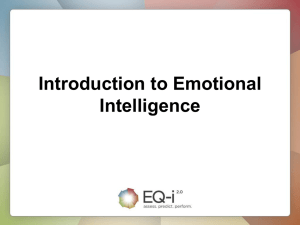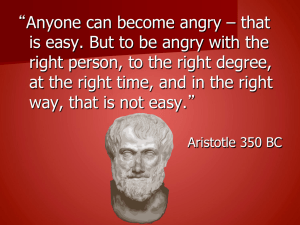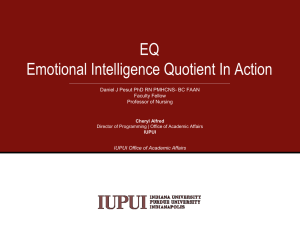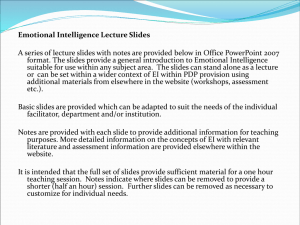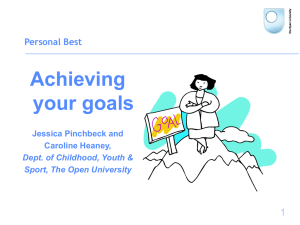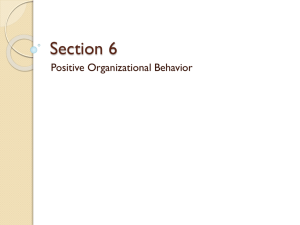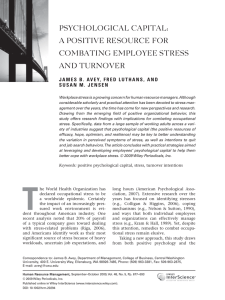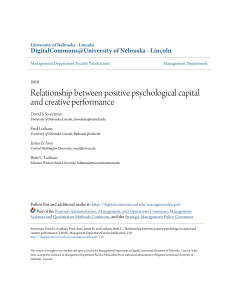evidence-based impact of positive psychological capital
advertisement
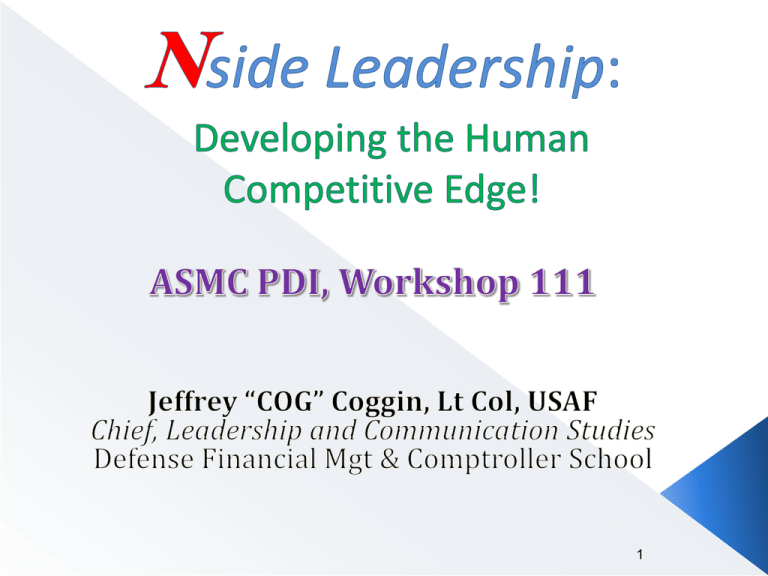
1 2 Nside Leadership Authentic Leadership Development The process that draws upon a leader’s life course, psychological capital (hope, confidence, resilience, and optimism), moral perspective, and a “highly developed” supporting organizational climate to produce greater self-awareness and self-regulated positive behaviors, which in turn foster continuous, positive self-development resulting in veritable, sustained performance. – Dr. Bruce J. Avolio (Research Advisor at University of Nebraska-Lincoln) Knowing others is intelligence; knowing yourself is true wisdom. Mastering others is strength, mastering yourself is true power. ~ Lao-Tzu He that knows himself knows others. ~ Colton If you know the enemy and know yourself, you need not fear a hundred battles. ~ Tzu-Sun Knowing yourself is the beginning of all wisdom. ~ Aristotle 5 Know thyself means this, that you get acquainted with what you know, and what you can do. ~ Menander Yes, know thyself: in great concerns or small. Be this thy care, for this, my friend, is all. ~ Juvenal Make it thy business to know thyself, which is the most difficult lesson in the world. ~ Miguel de Cervantes The only journey is the journey within. ~ Rainer Maria Rilke The unexamined life is not worth living. ~ Socrates 6 Nside Leadership Nside Leadership = “Self” Leadership “Self” Leadership has been broadly defined as "the process" of influencing oneself to establish the self-direction and selfmotivation needed to perform. The practice of effective self-leadership by employees can lead to numerous benefits including improved job satisfaction, selfconfidence, and mental performance. Nside Leadership requires strength within (strength with N) Background Scientist-Practitioner Perspective Holistic Approach: Mind-Body-Spirit Focus Areas: › Ancient Teachings › Cultural Practices › Scientific Discovery › Personal Life Experiences 9 Strength: physical power: the physical power to carry out demanding tasks. It took all our strength to lift the heavy table. emotional toughness: the necessary qualities required to deal with stressful or painful situations. She showed great strength throughout the trial. source of support: a source of strength or support resistance: the ability to withstand force, pressure, or stress "tensile strength" defensive ability: the ability to resist attack asset or quality: a valuable or useful ability, asset, or quality . One of the strengths of this system is its adaptability. Nstrength can be developed much like physical strength: › Regimented training program › Targeted muscle groups › Life long process › No Pain—No Gain! Nstrength (Phase I) Target Muscle Groups 1. 2. 3. 4. 5. Self-Awareness (SA) Emotional Intelligence (EI) Mindfulness (MI) Psychological Capital (PsyCap) Rational-Ethical Decision Making (Red) Work Performance = Success = $$$ Nstrength Teamwork & Effective Communication Morale, Retention, & Well-Being 13 Self-Awareness (SA) Self-Awareness: Aware of oneself, including one's traits, feelings, and behaviors. Tools to help increase one’s self-awareness › Myers-Briggs Type Indicator (MBTI) › True Colors® is a simple model of personality identification for people of all ages that improves communication through recognition of a persons true character. True Colors® utilizes the colors of gold, orange, blue, and green to differentiate four basic personality types. Self Awareness -At Work… (other areas of focus: In Love, In Childhood) Orange: Green: Gold: Blue: I am bored and restless with jobs that are routine and structured, and satisfied in careers that allow me independence and freedom while using my physical coordination and my love of tools. I view any kind of tool as an extension of self. I am a natural performer. I am conceptual and an independent thinker. For me, work is play. I am drawn to constant challenges in careers, and like to develop models, explore ideas, or build systems to satisfy my need to deal with the innovative. Once I have perfected an idea, I prefer to move on, leaving the project to be maintained and supported by others. I provide stability and can maintain organization. My ability to handle details and to work hard make me the backbone of many organizations. I believe that work comes before play, even if I must work overtime to complete the job. I have a strong desire to influence others so they lead more significant lives. I often work in the arts, communications, education, and the helping professions. I am adept at motivating and interacting with others. Reference: “Keys to Personal Success” (2008, Color Cards) by Don Lowry 16 Emotional Intelligence (EI) Anyone can become angry-that is easy. But to be angry with the right person, to the right degree, at the right time, for the right purpose, and in the right way—this is not easy. ~ Aristotle Emotional intelligence refers to the ability to recognize the meanings of emotion and their relationships, and to reason and problemsolve on the basis of them. Emotional intelligence is involved in the capacity to perceive emotions, assimilate emotion-related feelings, understand the information of those emotions, and manage them. Emotional Intelligence -5 Steps to Improve Your Emotional Intelligence: 1. 2. 3. 4. 5. Examine how you make appraisals. (Appraisals = impressions, interpretations, evaluations, and expectations YOU have about yourself, other people, and situations.) Tune in to your senses. (Seeing, hearing, smelling, tasting, and touching – the sources of ALL your data about the world) Get in touch with your feelings. (Although feelings are internal, they often have outward manifestations. By paying close attention to these outward signs, you can begin to understand the feelings they reflect. For example, you may find your face gets warm when you get embarrassed.) Learn what your intensions are. (Intentions can refer to your immediate desires: what you would like to accomplish today, in a specific situation, in the coming week.) Pay attention to your actions. (Actions are physical, they can be observed by others, and we can observe them if we choose. They may be considered clues to our attitudes and behavior. For example, speech patterns, body language, nonverbal behavior—enables you to help others perceive you more accurately.) Reference: “Emotional Intelligence at Work” (1998, Page 6-22) by Dr. Hendrie Weisinger 18 Mindfulness (MI) The practice of living in the present moment and experiencing things without judgment. Has both a mental and a physical component and emphasizes a mind-body connection. Can be a worthwhile practice for those who wish to reduce stress, manage pain, or cultivate personal awareness. Opportunity or Threat Mindfulness Npractice Self-Awareness Mindfulness - Scanning environment - Attention stability - Distinction making Leader reflects upon their: - Values - Identity - Emotions - Motives/Goals Self-Confidence - Domain specific - Based on practice/mastery - Improvement potential - Influence by others - Confidence is variable Cognitions + Emotions Empathy - Perspective Taking Decision Making or Problem Solving Process ACTION Decision Made Or Solution Obtained Mindfulness -While Out for a Walk: Take deep breaths and try to identify as many different smells as you can. 2. Pay close attention to all the sounds you can hear, particularly those you usually tune out. 3. Focus on everything your body is feeling: your sleeves against your arms (soft? scratchy?), your foot in your shoe (cramped? Springy), the surface under foot (hard? uneven?). 1. Reference: “Emotional Intelligence at Work” (1998, Page 12) by Dr. Hendrie Weisinger Economic Capital Psychological Capital What you have Human Capital What you know (PsyCap) Social Capital Who you know Psychological Capital Intentions for who you are and who you can become 22 Psychological Capital (PsyCap) Hope - A positive motivational state where two basic elements (“Will” Power and “Way” Power) interact. Self Confidence – Is defined as an individual's confidence in their ability to achieve a specific goal in a specific situation. Psychological Capital Optimism: › An optimistic person has an "Internal Locus of Control” regarding their life (I have influence over my future). › An optimistic person has a “situational or isolated focus” when it comes to negative events. This means they do not believe that a negative event will continue to occur (My failing grade on Exam 1 was a “one time” bad deal, I’ll do better on Exam 2). › Optimism relates to what an employee can or cannot do, as such, optimism reinforces self confidence and hope. Resiliency: A positive way of coping with danger or distress. In the workplace, it is defined as an ability to recuperate from stress, conflict, failure, change or increase in responsibility. PsyCap is positively related to work performance outcomes of all types. PsyCap development - Job satisfaction - Commitment - Engagement - Creativity increases: - Positive attitudes - Positive emotions - Trust in leadership - Well-being/Health 25 PsyCap -Hope Development: Practice generating goals that are personally valuable and reasonably challenging, that also include a clear beginning and ending point. Optimism Development: Building confidence in developing paths to our goals and overcoming obstacles increase positive expectations. As our expectations for success increase, so will our optimism. Self-Confidence Development: Practice laying out individual steps to accomplish our goals. Additionally, talk to others who have been successful in completing similar goals. Resiliency Development: Build awareness of your positive assets such as your talents, skills, and social networks. Focus on making plans to avoid obstacles that will prevent you from achieving your goals. Finally, choose to focus on resilient thoughts to overcome adversity. Reference: “Psychological Capital: Developing the Human Competitive Edge” (2007, Page 215) by Fred Luthans, Carolyn M. Youssef, & Bruce J. Avolio. 26 Rational & Ethical Decision Making (Red) Rational = able to think clearly and sensibly, unimpaired by physical or mental condition, strong emotion, or prejudice Ethical = conforming to accepted standards: consistent with agreed principles of correct moral conduct High Mental Workload = Too much “stimulus” can short-circuit rational, ethical decision making. (Fire Hose Effect//Fog & Friction) › Emotions (e.g., anger/lust) can over-ride logic, facts, integrity, & common sense. Enhanced Problem Solving & Decision Making The OODA loop (observe, orient, decide, and act) is a decision making model originally designed for air-to-air combat in the Korean War . › OODA Loop was developed by military strategist and USAF officer, Colonel John Boyd. The OODA Loop is now often applied to understanding commercial operations and learning processes. (e.g. AFSO 21) O-O-D-A Loop 5-ACT The Cognitive Miser (Lazy Thinker) 3-ORIENT Interaction between: 2-OBSERVE External Environment - Unfolding Events - Outside Information -Interaction with Environment Focus: Mindfulness - New Information - Genetic Heritage - Cultural Traditions - Experience/Training -Analyses & Synthesis FOCUS: •Short Term Sensory Storage (Sight, Sound, Smell, Touch) •Working Memory (Reduced capacity due to prolonged periods of stress •Long Term Memory (Knowledge and Emotional Experiences) Feedback 4-DECIDE (Hypothesis) Focus: • Working Memory Capacity • Critical Thinking Skills • Realistic & Effective Training 1-Nstrength FOCUS: •SA/EI/MI/PSYCAP/RED Feedback (Unfolding interaction with environment) Rational-Ethical D.M. -Identify the Issue Analyze the Issue Clarify & Validate the Problem Standardize Successful Processes Break Down the Problem/ Identify Performance Gaps Develop Alternatives Confirm Results & Processes Set Improvement Target Evaluate Alternatives See Countermeasures Through Determine Root Cause Make a Recommendation Develop Countermeasures 32 Nstrength facilitates Self/Inside Leadership › Possibly the most important type of leadership known Nstrength can be developed in short (3 hour), highly focused development sessions/modules. Nstrength can accelerate the development of “wisdom” over one’s life. › May prevent individuals from making those “3 Second” bad decisions that last a life time or cost a life. › Increase overall happiness and fulfillment – hopefully making one’s life too precious to destroy. Nstrength: Close’N Thought There is a person with whom you spend more time than any other, a person who has more influence over you, and more ability to interfere with or to support your growth than anyone else. This ever-present companion is your own self. -Dr. Pamela Butler, Clinical Psychologist 35 Jeffrey “COG” Coggin, Lt Col, USAF DSN: 493-3488//COMM: 334-953-3488 E-Mail: jeffrey.coggin@maxwell.af.mil The N THANK YOU! 36
